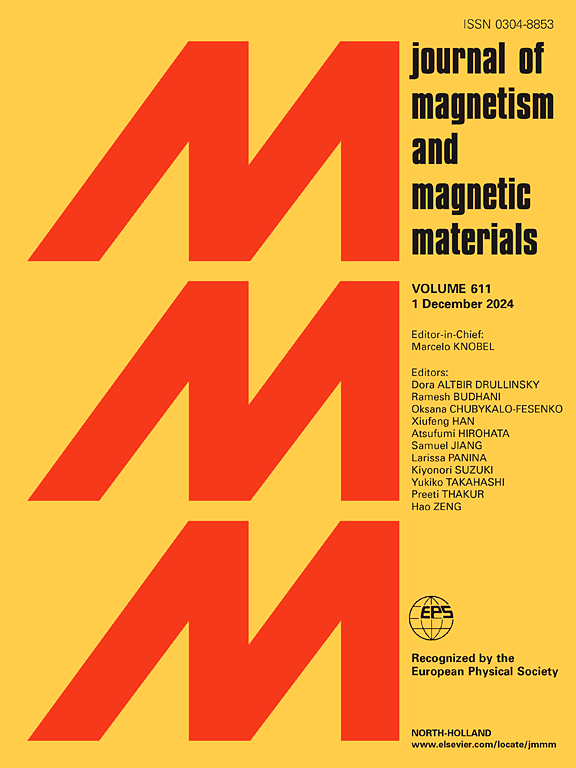研究Fe2@Genα (α = 0, +1,−1,n = 1 - 13)纳米团簇的结构,电子和磁性:DFT见解
IF 2.5
3区 材料科学
Q3 MATERIALS SCIENCE, MULTIDISCIPLINARY
引用次数: 0
摘要
在这项研究中,我们对带电铁锗纳米团簇进行了全面的研究,记为Fe2Genα (α = 0,±1;n = 1-13),使用密度泛函理论(DFT)。我们的主要重点在于了解它们的结构、电子和磁性。结果表明,随着簇大小的增加,结合能逐渐增加,表明随着簇大小的增加,稳定性增强。值得注意的是,Fe2Ge10和Fe2Ge12表现出特殊的热力学稳定性,表明这些特定成分具有“幻数”行为。随着团簇尺寸的增大,最高已占据分子轨道-最低未占据分子轨道(HOMO-LUMO)的间隙有系统地缩小,中性和阴离子团簇的间隙在1.5 ~ 2.5 eV之间,这表明电子性质是可调的。结构分析表明,在锗基笼状框架中加入铁原子显著提高了簇的整体稳定性。此外,从Fe到周围Ge原子的电荷转移在调节电子分布和磁行为方面起着关键作用。大多数团簇的磁矩约为6 μB,但Fe2Ge9的磁矩约为4 μB。这些对Fe-Ge纳米团簇的结构-性能关系的见解突出了它们在纳米技术中的应用前景,特别是在功能团簇基材料的合理设计方面。本文章由计算机程序翻译,如有差异,请以英文原文为准。

Investigating the structural, electronic, and magnetic properties of Fe2@Genα (α = 0, +1, −1, n = 1–13) nanoclusters: DFT insights
In this study, we perform a comprehensive investigation of charged iron-germanium nanoclusters, denoted as Fe2Genα (α = 0, ±1; n = 1–13), using density functional theory (DFT). Our primary focus lies in understanding their structural, electronic, and magnetic characteristics. The results reveal a progressive increase in binding energy with cluster size, indicating enhanced stability as the cluster size increases. Notably, Fe2Ge10 and Fe2Ge12 exhibit exceptional thermodynamic stability, suggesting “magic number” behavior for these specific compositions. The highest occupied molecular orbital–lowest unoccupied molecular orbital (HOMO–LUMO) gap systematically narrows with increasing cluster size, ranging between 1.5 and 2.5 eV for both neutral and anionic clusters, which points to tunable electronic properties. Structural analysis indicates that the incorporation of Fe atoms into germanium-based cage-like frameworks significantly enhances the overall stability of the clusters. Moreover, charge transfer from Fe to surrounding Ge atoms plays a critical role in modulating both electron distribution and magnetic behavior. Most clusters exhibit a total magnetic moment of approximately 6 μB, with the notable exception of Fe2Ge9, which displays a reduced moment of 4 μB. These insights into the structure–property relationships of Fe–Ge nanoclusters highlight their promise for applications in nanotechnology, particularly in the rational design of functional cluster-based materials.
求助全文
通过发布文献求助,成功后即可免费获取论文全文。
去求助
来源期刊

Journal of Magnetism and Magnetic Materials
物理-材料科学:综合
CiteScore
5.30
自引率
11.10%
发文量
1149
审稿时长
59 days
期刊介绍:
The Journal of Magnetism and Magnetic Materials provides an important forum for the disclosure and discussion of original contributions covering the whole spectrum of topics, from basic magnetism to the technology and applications of magnetic materials. The journal encourages greater interaction between the basic and applied sub-disciplines of magnetism with comprehensive review articles, in addition to full-length contributions. In addition, other categories of contributions are welcome, including Critical Focused issues, Current Perspectives and Outreach to the General Public.
Main Categories:
Full-length articles:
Technically original research documents that report results of value to the communities that comprise the journal audience. The link between chemical, structural and microstructural properties on the one hand and magnetic properties on the other hand are encouraged.
In addition to general topics covering all areas of magnetism and magnetic materials, the full-length articles also include three sub-sections, focusing on Nanomagnetism, Spintronics and Applications.
The sub-section on Nanomagnetism contains articles on magnetic nanoparticles, nanowires, thin films, 2D materials and other nanoscale magnetic materials and their applications.
The sub-section on Spintronics contains articles on magnetoresistance, magnetoimpedance, magneto-optical phenomena, Micro-Electro-Mechanical Systems (MEMS), and other topics related to spin current control and magneto-transport phenomena. The sub-section on Applications display papers that focus on applications of magnetic materials. The applications need to show a connection to magnetism.
Review articles:
Review articles organize, clarify, and summarize existing major works in the areas covered by the Journal and provide comprehensive citations to the full spectrum of relevant literature.
 求助内容:
求助内容: 应助结果提醒方式:
应助结果提醒方式:


